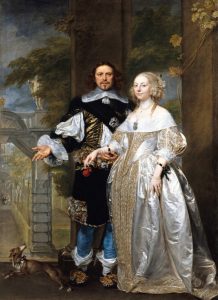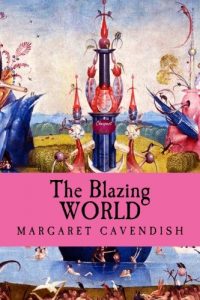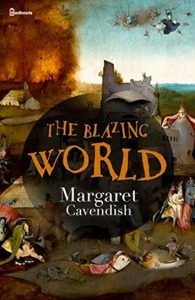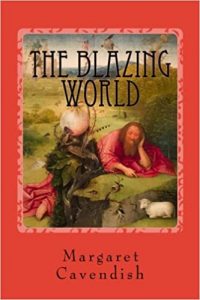 Today, let’s sail through the Icy Seas, around the Poles of the world, to the Blazing World, whereupon we shall frolic with the Bear-Men, and the Fox-Men, and those wise beings of a Grass-Green Complexion — let us journey to a Fiery Sphere of feminism.
Today, let’s sail through the Icy Seas, around the Poles of the world, to the Blazing World, whereupon we shall frolic with the Bear-Men, and the Fox-Men, and those wise beings of a Grass-Green Complexion — let us journey to a Fiery Sphere of feminism.
“Mad Madge,” aka Margaret Cavendish, forged the path in 1666 for all writers of science fiction through her creation of one of the earliest true science fiction novels, The Blazing World — starting a revolution in concepts of gender and science. (And she excelled in pissing men off.)
Science fiction and total narrative control of worlds makes it genre ideally suited for Utopians and thought experiments/conversations. It is a genre that can be utilized by the marginalized to effect cultural change. Margaret Cavendish used this power to flesh out her ideas about politics and the ability of science (as opposed to theology) to ask and answer questions about society through the vehicle of fiction.
Margaret Lucas Cavendish, Duchess of Newcastle-upon-Tyne was born in 1623, the youngest sister in a Royalist family. She became an attendant of Queen Henrietta Maria, traveling with her into exile in France. There, they lived for a time at the court of young King Louis XIV in Paris, where she met and married, William Cavendish when he was just a marquess, becoming his second wife.
A philosopher, poet, scientist, and playwright, she unabashedly self-published under her own name, during a time when women ONLY published using a male or gender-neutral alias. The Blazing World, published in January of 1666, is a Utopian romance and one of the first science fiction books addressing gender, power, manners, scientific method, and philosophy.

So why did her contemporary, gossip columnist extraordinaire, Samuel Pepys call her, “mad, conceited and ridiculous?” What truly vile sins did the lady commit?
She dressed as she pleased.
She liked to design and wear her own fashions, refusing to conform to society. One notable instance occurred when she attended a play written by her husband, in one of her own designs — an outfit based on Cretan clothing, and featuring her bare breasts (Grant 110).
She cursed.
As contemporary Mary Evelyn recorded, her conversation was “airy, empty whimsical … terminating commonly in nonsense, oaths, and obscenity” (17).
 She liked a good entrance.
She liked a good entrance.
Setting: The Royal Society, center of scientific research and discussion. Men only. She tries repeatedly to join.
Debarred by her sex from participation in the august society, she nevertheless receives an invitation to attend a viewing as a guest.
She arrives to the meeting, late. In a coach. With all of her women, six of whom were needed to carry her train, throwing all those men into confusion and pandemonium, especially because one of her women (the noted singer and beauty Ferrabosco) was dark-skinned (23-26).
Her attendance caused a spectacular spectacle.
Snap!
She brought her posse and showed the Royal Society up, while also giving a chance for her friends to see the wonders of science.
AND the Lady could write.
The Blazing World is an account of a voyage to a Utopian world. It starts with a lady being kidnapped by pirates, who then abandon her in the Blazing World, a land inhabited by color-coded beings (aliens) who communicate through telepathy. The lady marries the Emperor of this strange land, and then shit gets very meta — the Empress develops a mystical connection with the Duchess, who writes herself into the story.
The Blazing World is, I admit, a tough read for modern audiences. Much of the book is conversations of philosophy and theories, the action is mostly off-stage, and the meta aspects can be…difficult. The plot…rambles. It is fairly incoherent. Still, it is a science fiction, in that it uses science to question the nature of reality and gender.
Anyone writing science fiction owes a deep debt to Lady Cavendish. From her, one can trace the lineage of science fiction as a genre of idea exploration, from Swift’s Gulliver’s Travel’s (1726), through the mother of the genre, Mary Shelley, and of course, the father of science fiction in its modern form, H.G. Wells.
Gulliver’s Travel’s, like The Blazing World, is also a prose travelogue, using fantasy (instead of science) conventions to discuss philosophies. Both use the genre of satire to parody travel narratives and scientific speculation, while offering their own observations and rebuttals to contemporaries.
Mary Shelley used Cavendish’s concept of the North as a fluid utopia in Frankenstein (1818), but more importantly also utilized the notion of the “other” to forward her philosophical arguments on the nature of humanity and gender.
H.G. Wells availed himself of her techniques in The Time Machine (1895), among others, to discuss (again) natural philosophies. Like Cavendish, he used the genre of science fiction to mirror common conceptions, especially those relating to gender.
Which makes her, in effect, the grandma of SF. The Matriarch. The Empress.
That though I cannot be Henry the Fifth, or Charles the Second; yet, I will endeavour to be, Margaret the First: and, though I have neither Power, Time nor Occasion, to be a great Conqueror, like Alexander, or Cesar; yet, rather than not be Mistress of a World, since Fortune and the Fates would give me none, I have made One of my own. And thus, believing, or, at least, hoping, that no Creature can, or will, Envy me for this World of mine, I remain,
Noble Ladies, Your Humble Servant, M. Newcastle.
Cavendish Newcastle, Margaret. The Description of a New World, Called the Blazing-World. Project Gutenberg, Retrieved February 2, 2020, from http://www.gutenberg.org/ebooks/51783.
Grant, Douglas. Margaret the First. Toronto: University Press, 1957.







No Comments